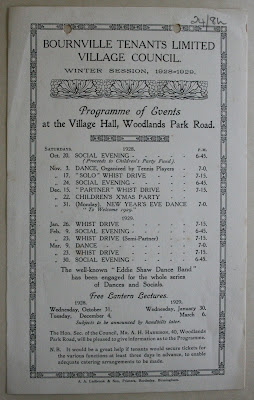In the early years of the Bournville Tenants Estate a promotional booklet was produced filled with photographs of the new housing and information about the society, published in about 1909. A copy of the booklet is owned by a local resident, and is reproduced below, but other copies are held in Birmingham Archive (see here). There are some differences between the two copies, and those held in the Archive were probably produced a year or two later.
Click on the images to enlarge.
 |
| Page 1. |
BOURNVILLE TENANTS LTD
Registered Office: ESTATE OFFICE, NORTHFIELD RD, KINGS NORTON
 |
| Page 2. |
The "Garden City" has come to stay. It provides ideal conditions for English homes: it enables the workers to live amid beautiful and healthy surroundings. In the future the people may work in the city, but they will live in the country, and the homes of the children will be where there are fresh air, sunshine, trees and flowers.
 |
| Page 3. |
THE BOURNVILLE TENANTS LIMITED
 |
| Page 4. |
PAIR OF COTTAGES, WOODLANDS PARK ROAD.
Each Cottage stands in 600 yards of ground: the house is set back 10 yards from the road, thus giving a good garden plot or lawn in front. The accommodation afforded includes two sitting-rooms, large kitchen, three bed rooms, bath-room (hot and cold water), w.c., and the usual outhouses.
 |
| Page 5. |
NORTHFIELD ROAD, SHOWING THE APPROACH TO THE ESTATE FROM THE STATION.
The Estate is most conveniently situated, being from six to ten minutes' walk from the King's Norton Station (Midland Railway), with a frequent and convenient service of trains to New Street, Birmingham.
[
NB: This is actually looking towards the station]
 |
| Page 6. |
NORTHFIELD ROAD, SHOWING FRONT GARDENS.
The large gardens provided with the cottages on the estate afford opportunities for pleasant occupation after a day spent in the city. The tenants are enthusiastic gardeners, and during the summer months the front gardens present an attractive and pretty appearance, with a large variety of flowers and evergreens.
 |
| Page 7. |
THE BOURNVILLE TENANTS LIMITED IS A CO-PARTNERSHIP BUILDING SOCIETY.
 |
| Page 8. |
ENTRANCE TO WOODLANDS PARK ROAD.
The road winds gracefully down the side of the hill towards the north-west, running at the further end into Bristol Road. This position commands a view of the well-wooded Worcestershire and Warwickshire countryside, towards Bournville and Harborne, to the famous Frankley Beeches and Warley Woods, the latter being about seven miles distant.
 |
| Page 9. |
A FEW HOUSES IN NORTHFIELD ROAD.
 |
| Page 10. |
WOODLANDS PARK ROAD.
The Society began to build in Woodlands Park Road, on the site here shown, in November 1906.
 |
| Page 11. |
COTTAGES ON KINGSLEY ROAD
The Society has secured the services as Architect of
Mr. W. Alex. Harvey of Birmingham (Consulting Architect to the Bournville Village Trust), who is one of the foremost experts in Garden City Development. Mr. Harvey's site plan combines the advantages of picturesque grouping of the cottages with economy in road-making, and also provides most efficiently for the residents' use of open spaces and recreation grounds provided in the village.
[
NB: The top-left photograph shows 170 & 168 Northfield Road, not Kingsely Road]
 |
| Page 12. |
QUADRANGLE, KINGSLEY ROAD.--A group of twelve cottages, in three blocks, designed in a simple character, and arranged on three sides of a common green. Breaks the building line in a pleasing manner, and forms an attractive feature of the road.
 |
| Page 13. |
EDUCATION AND RECREATION.
 |
| Page 14. |
COTTAGES IN COURSE OF ERECTION, HAWTHORNE ROAD.
 |
| Page 15. |
FINANCE.
 |
| Page 16. |
Designed and produced by J. Charlton & Co., Ltd.
Design & Illustrations
The back page is printed with 'Designed and produced by J. Charlton & Co., Ltd.', but this is underlined in pencil, and the text 'Stanley Williams, Lench, and Charlton is written. Presumably, 'Stanley Williams' and 'Lench' were the '& Co.'.
James Charlton, an illustrator and wood engraver, lived at
12 Woodlands Park Road, probably moving in as the house was built, and remaining until the early 1930s, when
Stanley Williams moved into the same address. No-one called 'Lench' has yet been found on the estate.
Copy of the Booklet in Birmingham Archive
The booklet in Birmingham Archive is almost identical to the one owned locally, but the colours of the front cover are inverted, and a new photograph of the top recreation ground has been added to page 13. Apart from this, the booklet is the same, but photos are included
here for reference.




















































